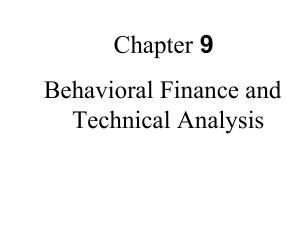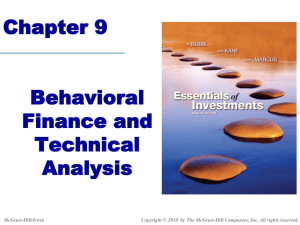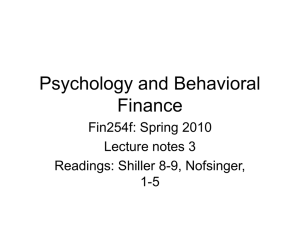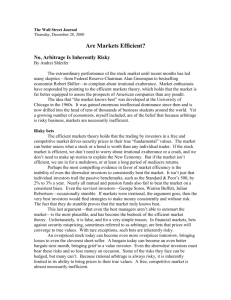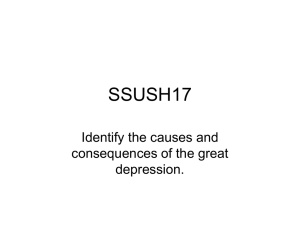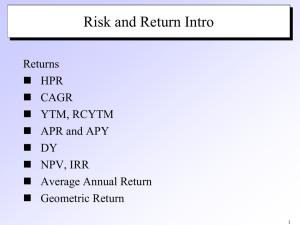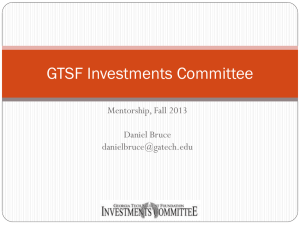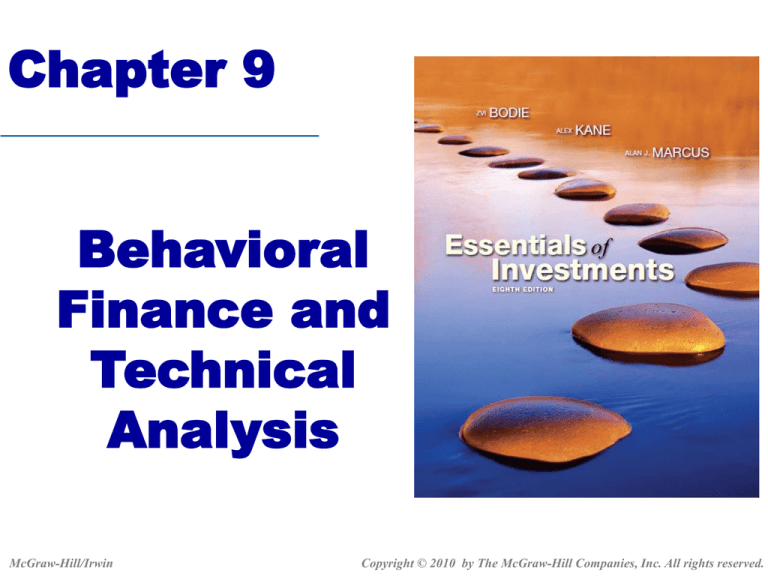
Chapter 9
Behavioral
Finance and
Technical
Analysis
McGraw-Hill/Irwin
Copyright © 2010 by The McGraw-Hill Companies, Inc. All rights reserved.
9.1 The Behavioral Critique
9-2
Behavioralism bias
• Motivation
Stock prices in the 1990s did not appear to match
“fundamentals,”
e.g., high price earnings ratios
Evidence of refusal to sell losers
Economics discipline is exploring behavioral aspects
of decision making
9-3
Behavioralism
• Extrapolation bias
• Analysts tend to excessively extrapolate historical
trends when forecasting.
• May lead to unsustainably high P/E ratios.
• Overconfidence
Some people exhibit overconfidence in their ability to
pick stocks or have an exaggerated belief that ‘risk’ will
hurt the other person but not them. As a result, they bid
stock prices too high.
9-4
Behavioralism
• Anchoring Bias & earnings
Many people become anchored to their ideas and will not
update their expectations when new information arrives.
This underreaction to news leads to momentum in stock
returns.
9-5
Behavioralism
• Framing errors
– Mental accounting
When cash is needed investors may spend
dividends, but refuse to sell a small portion of
stock to raise the money.
This may lead to a preference for stocks that
pay larger dividends, even though tax liability
may be greater.
9-6
Behavioralism
• Framing errors
– Regret Avoidance
• Regret from losses is greater than joy from
gains.
• Regret is reduced with ‘shared pain.’
In order to induce investors to buy out of
favor stocks, stocks with poor recent
performance for example (value stocks),
these stocks have to pay a higher expected
return.
9-7
Behavioralism & Prospect Theory
Standard utility (satisfaction) theory versus prospect
theory
• Standard utility theory of investments:
– Investors desire more wealth and less risk
– Wealth provides diminishing marginal utility, thus
a gain of $1,000 provides less utility than the
utility loss from losing $1,000.
• This gives rise to risk aversion.
• Prospect theory:
An alternative behavioral theory suggesting that
investor utility depends on the change in wealth
from the start of the investment rather than on the
starting level of wealth.
9-8
Prospect Theory Illustrated
9-9
A Example of the Effect of Framing
(Kahneman and Tversky, 1979)
• The following two problems were
presented to two different groups of
subjects.
• In addition to whatever you own, you have
been given $1,000. You are now asked to
decide whether to accept a sure $500 gain
or play a gamble. The gamble features a
50-50 chance of winning $1,000 more or
nothing more.
A Example of the Effect of Framing
• In addition to whatever you own, you have been
given $2,000. You are now asked to decide
whether to accept a sure $500 loss or play a
gamble. The gamble features a 50-50 chance of
losing $1,000 more or nothing.
• 84% of subjects chose the sure $500 in the first
problem, a choice consistent with risk-aversion.
Yet, 69% of subjects chose the gamble in the
second problem, a choice consistent with riskseeking.
Why not arbitrage mispriced
stocks?
• If some investors are letting behavioral
biases affect prices, why don’t other better
trained investors engage in profitable
arbitrage?
•
Part of reason for growth in hedge funds.
9-12
Limits to arbitrage
• Fundamental Risk
Changes in fundamentals can wipe out any
arbitrage profits, making the strategy risky.
• Short sale constraints
Short sale constraints make it difficult to
arbitrage overpriced securities.
• Model Risk
How do you know when a security is truly
mispriced? Your model may be giving you
wrong signals.
9-13
Figure 9.2 Pricing of Royal Dutch
Relative to Shell (Deviation from Parity)
60:40 split of profits from merger between RD and Shell
Stock price ratio RD/Shell should = 60/40 = 1.5
If RD/Shell > 1.5 then short RD and buy Shell
If you had done this in 1993, you would have LOST money until 1999.
9-14
Critiquing the Behavioral Critique
•
•
It provides ______
stories that fit _________________
individual situations but
there is no ______________
coherent theory put forth and
_____________________________.
some
behaviors contradict others
Much of the empirical support for the behavioralist
ideas in investments comes from one
_______________
specific time
___________________.
period, the late 1990s
Behavioralism has less to say about ____________
informational
efficiency and more to do with allocational
efficiency
_________
__________________
•
The behavioral literature is very
___________
weak at
___________________________________.
providing
solutions to these problems
9-15
9.2 Technical Analysis and
Behavioral Finance
9-16
Technical Trading Rules
1. Conceptual basis
– All technical analysis (TA) assumes that there are
recurring and predictable patterns in stock prices
which can be exploited to earn abnormal returns.
– Technical analysts believe:
• Market prices conform to new data only slowly,
giving rise to price trends
• Prices are affected by predictable behavioral or
psychological factors
9-17
Point & Figure Charts
9-18
Point & Figure Charts
9-19
Point & Figure Charts
9-20
Basic Types of Technical
Analysis
2. Identifying trends using moving averages
Insert Figure 9.7 here, move it
to the back, line up the SMA
arrow with the smooth line in
the graph
SMA Line
50 period simple moving average (SMA) for
INTEL superimposed on INTEL prices.
Crossing the SMA from above is a bear signal.
9-21
Figure 9.8 Level of the DJIA and
the 5-Week Moving Average
9-22
Basic Types of Technical
Analysis
3. Dow Theory
“Tertiary
”
• Three types of trends, only two are important
• Every stock has price peaks and troughs but if a series
of peaks and troughs are rising it is a buy signal
especially if volume is heavier during the peaks than
the troughs
9-23
Basic Types of Technical Analysis
4. Relative Strength
A simple relative strength ratio could be constructed as
ΔPi / ΔIndex
___________.
Increases in the relative strength ratio indicate the stock
is outperforming the index and could indicate a buy or
bullish signal.
9-24
Basic Types of Technical
Analysis
5. Breadth
– Breadth is the extent to which movements in a
broad index are reflected widely in movements
of individual stocks
– Measured as the difference between the number
of advancing and declining stocks
– Also used in industry indexes
9-25
Cumulative Breadth
• Cumulative breadth is found by adding the current
day’s net advances or declines to the previous day’s
total.
• The purpose is to gauge the trend.
9-26
Basic Types of Technical Analysis
6. Odd Lot index
Odd Lot traders are mostly individual investors that are
relatively uninformed.
Contrarian philosophy … Do the opposite of the majority
of the odd lot traders.
9-27
TA Sentiment Indicators
8. Short Interest
• Total number of shares of stock currently sold
short
• High short interest may indicate that a stock’s price
is expected to fall.
9-28
TA Sentiment Indicators
8. Trin Statistic
Volume declining/Number declining
Trin =
Volume advancing/Number advancing
9-29
TA Sentiment Indicators
• Confidence index
– Ratio of the average yield on 10 top-rated
corporate bonds divided by the average
yield on 10 intermediate-grade corporate
bonds
• Put/call ratio
– Call options give investors the right to buy
at a fixed exercise price and a put is the
right to sell at a fixed exercise price
– Change in ratio can be given a bullish or
bearish interpretation
9-30
A Warning About Identifying
Trends
• Difficulty in identifying common price patterns
One of these patterns is real and one of these is
computer simulated with random price
changes. Can you tell which is which?
Point? • Less than meets the eye
• Data mining
9-31
Figure 9.11 Actual and Simulated Changes
in Weekly Stock Prices for 52 Weeks
9-32
Selected Problems
9-33
Problem 1
a.
– The prices of growth stocks may be consistently bid too high due
to investor overconfidence.
– Investors/analysts may extrapolate recent earnings (and dividend)
growth too far into the future and thereby inflate stock prices,
forcing poor returns eventually on growth portfolios.
– At any given time, historically high growth firms may revert to
lower growth and value stocks may revert to higher growth,
changing return patterns, this may happen over an extended time
horizon.
9-34
Problem 1
b. Enough investors should prefer value stocks to growth
stocks and bid up the prices of value stocks and drive
down the prices of growth stocks until the “extra” return
on the value stocks was eliminated.
9-35
Problem 2
a. Regret avoidance is indicated by his desire to sell when price rises
to the cost basis. If this happens, it may indicate they may now be
good performers and should be held.
o
Fix: Look at expected return or terminal wealth not past losses.
9-36
Problem 2
b. Extrapolation bias: Can lead to overconfidence about future
performance of Country XYZ.
o
Fix:
Diversification benefits are greater if we spread the investments
and we would want a forward looking forecast of international
investments
9-37
Problem 2
c. Mental accounting, mentally separating the speculative account
from the retirement account.
o
Fix:
The investor should maximize the return per unit of risk for
the entire portfolio, not for arbitrary subsets where the client
exhibits different levels of risk aversion.
9-38

